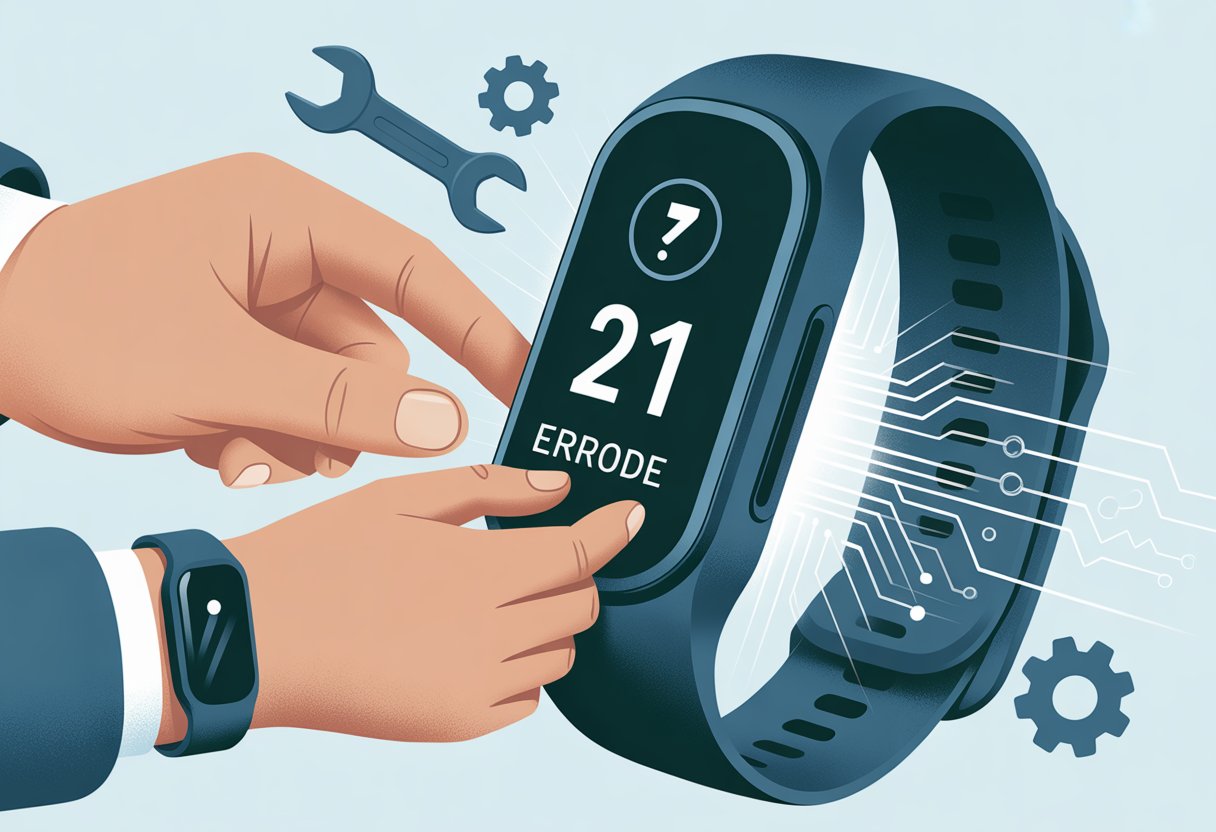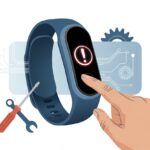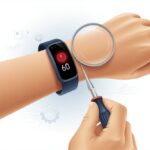Let’s be real for a second. We’ve all been pumped for a workout, only to have our fitness tracker or treadmill flash that dreaded Error Code 21.
It’s like the machine decides to nap right when we’re finally motivated. Error code 21 usually means the machine isn’t getting the right speed signal, or the motor and speed sensor aren’t communicating—so it just stops, leaving us standing there, confused.

If you’ve ever stared at Error 21 on your treadmill or tracker, you’re not alone. It’s frustrating, but sometimes the fix is as easy as checking a loose wire, doing a quick reset, or brushing off some dust that’s messing with the sensor.
Honestly, if dealing with tech issues makes you sweat more than your workout, we totally get it. We’ve been there too.
Let’s try to turn that annoyance into a win. We’ll break down what’s really going on with this error—no tech jargon, just real talk.
Ready to get back to crushing your fitness goals? Let’s dive in.
What Is Fitness Tracker Error Code 21?
Error code 21 isn’t just a random number out to ruin your day. It’s your fitness gadget’s way of waving a tiny white flag.
When you see this code, your device is basically saying something’s wrong, and it needs a little help. What exactly is it complaining about this time?
Common Symptoms of Code 21
Error 21 doesn’t show up quietly. It usually makes its presence known right when you’re ready to get moving.
You might see “code 21” or “error 21” pop up on your screen. Sometimes, your tracker just stops counting steps, ignores your heart rate, or won’t sync with your phone—classic drama.
Other times, the screen freezes, flashes weird symbols, or keeps restarting in an endless loop. It’s like your device is on strike.
Flashing lights but no progress? That’s another sign. Fitness trackers sure know how to make a scene when code 21 appears.
Your tracker might even refuse to power on, or it’ll shut off the second you hit start. Sometimes it feels like it’s taunting you: “Go ahead, try walking now!”
When you spot any of these odd behaviors, code 21 is probably the villain.
Devices Commonly Affected
Code 21 doesn’t play favorites. You’ll find it on all sorts of fitness trackers.
We’ve seen it on big names like Fitbit and Garmin, plus plenty of off-brand models. If it tracks steps or your heartbeat, it’s fair game for error 21.
Treadmills and smart gym gear aren’t safe either. Some treadmill owners have found that error 21 shows up when the speed sensor isn’t sending info, and the machine throws a mini tantrum.
Honestly, this error isn’t loyal to any brand or model. Whether your device lives on your wrist or collects dust under the couch, it might just hit you with error 21 one day.
Why Error Code 21 Happens on Fitness Trackers
Error Code 21 on your fitness tracker isn’t just a random glitch. It’s your device’s way of begging for attention.
Often, it’s a mechanical problem that needs more than just a restart. Annoying, right?
Motor Issues and Power Demand
When Error Code 21 shows up, the treadmill’s motor is usually struggling. Motors need steady power to work well.
If the motor gets overloaded or works too hard, it can’t keep up, and Error 21 appears.
Sometimes, the treadmill tries to speed up too fast. The motor can’t handle it, and—bam—Error 21.
Low voltage, damaged cords, or a weak relay can also leave the motor starved for power.
Techs say that too many power demands, especially with a bad relay or lower board, can overwhelm the system. That’s when your treadmill gives up and flashes Error 21.
On some models, it’s dramatic: if the problem doesn’t fix itself, you might need to replace a board (like the advice about a bad relay on the lower board).
Belt and Deck Wear Conundrums
If your treadmill’s belt and deck look more worn out than your old sneakers, Error 21 might appear. A worn or dry belt makes the motor work overtime.
The poor motor ends up straining, as if it’s running through mud.
When the deck isn’t smooth or the belt isn’t lubricated, the system notices the motor is working too hard. It shuts down to protect itself, and up comes that error code.
Sometimes, debris gets stuck in the belt or rollers, making every walk feel like a hike through gravel. That extra drag confuses the sensors and triggers the alarm.
A quick check of your treadmill’s deck, belt, and sensors can help you dodge error 21.
Step-By-Step Solutions to Fix Error Code 21
Error 21 usually means your fitness tracker is having a rough day, most often because of motor or connection problems.
You can often fix it by resetting the device, checking the motor brushes, and making sure everything’s plugged in tight.
Resetting Your Device the Right Way
Let’s start with the old standby: turning it off and on again. But there’s a right way to do it.
Power down the tracker, unplug it, and take out any batteries. If your device has a display, give it a minute for everything to fully shut down.
Pop the battery back in and plug it up. Power it on and cross your fingers—hopefully Error 21 takes a hike.
If it sticks around, double-check for firmware updates. Sometimes, manufacturers sneak in fixes for these issues without much warning.
For a visual guide, check out instructions like those treadmill techs use for resetting the display and battery.
Checking and Replacing Motor Brushes
If Error 21 won’t disappear, the motor brushes could be the problem. These little carbon blocks help the motor spin but wear down over time—like tiny erasers.
Unplug your device (seriously, safety first). Most trackers with motors have an access panel.
Open it up, find the motor, and look for the brushes. If they’re under ¼ inch long, it’s time for new ones.
Swapping them out only takes a few minutes. Once you’ve got the new brushes in, plug it all back up and see if Error 21 is gone.
You can also test the motor directly with a separate battery, as explained in some treadmill troubleshooting guides. If the motor won’t spin, the brushes are probably the issue.
Inspecting Wire Harness and Connections
Now, let’s play detective and check the wires. Fitness trackers with motors have a tangle of wires connecting the power board to the motor.
A loose or damaged wire can trigger Error 21 and send you on a wild goose chase.
Unplug everything (again, better safe than sorry). Gently wiggle connectors and harnesses, looking for anything loose or broken.
If a connector is barely attached, press it in firmly. Burnt or corroded parts should be cleaned or replaced.
Here’s a quick checklist:
| Step | What To Check | What To Do |
|---|---|---|
| 1 | All harness connections | Push firmly in |
| 2 | Wires for damage | Replace if frayed |
| 3 | Motor terminals | Tighten/clean |
If you’ve checked everything and Error 21 still won’t budge, you might be dealing with a deeper internal problem.
For more help, check out detailed troubleshooting steps for similar devices.
Advanced Troubleshooting for Persistent Error 21
When error 21 just won’t go away, it usually points to bigger issues inside your tracker or treadmill.
You might have to get your hands dirty and check electrical components to get things working again.
Testing and Swapping Drive Motors
Let’s talk drive motors. These parts keep your machine moving, but sometimes they get tired—or just stubborn.
If error 21 keeps showing up, your drive motor might be struggling.
Grab a multimeter and check the voltage at different speeds. A healthy motor gives steady readings and runs smoothly as you adjust speed.
If it makes weird noises or the belt jerks, it might be time to swap it out.
Before blaming the motor completely, try swapping in a known good one from another unit if you have one handy. If the error vanishes, your original motor probably gave up.
If not, keep troubleshooting.
Checking the Motor Controller Board
Nothing says “electrical mischief” like a tricky controller board. This little circuit tells your treadmill’s motor what to do.
If error 21 won’t disappear, give the controller board a good look.
Check for burnt smells, melted parts, or scorch marks—think of yourself as a mini appliance detective.
Wiggle connectors and look for frayed wires. If you’re handy with a meter, check the voltage in and out of the board.
Often, error 21 comes from a weak or shorted relay, like in this error code 21 and bad relay advice.
You might need to replace the relay—or, worst case, the whole board.
When to Replace the Filter Capacitor
A filter capacitor smooths out bumps in the electric flow—kind of like calming a hyper puppy.
When this part goes bad, the whole system can freak out and throw error 21 our way.
Here’s a simple trick: look for bulging, leaking, or crusty goo on the cap.
If the machine runs for a few seconds and then errors out as soon as the motor draws serious power, that’s another clue.
Swapping out the filter capacitor isn’t too tough if you’ve ever used a soldering iron without burning the house down.
If soldering feels intimidating, it’s totally fine to call in backup.
Just don’t lick the capacitor (yeah, believe it or not, that’s happened).
New filter capacitors don’t cost much, and swapping an old one out can bring a dead machine back to life.
Lower PCA Board Jumpers (Advanced Only!)
Now we’re getting fancy!
The lower PCA board uses jumpers—those tiny plastic clips—to tell the machine how much juice to expect.
If the jumpers go missing or end up in the wrong spot, error 21 will pop up, and sometimes the treadmill won’t even start.
This step’s for the brave (and for folks who don’t lose small parts easily).
First, double-check the treadmill’s voltage settings—US units might need a jumper installed for 120V, while others won’t.
You can find more details in guides about treadmill jumpers and error 21.
If moving the jumper doesn’t fix error 21, check the connection—dust or corrosion can mess with the contacts.
Only mess with board jumpers if you’re sure about what you’re doing, unless “living dangerously” is your fitness motto.
Prevention Tips to Keep Error 21 Away
Nobody wants their fitness tracker sounding like a spaceship about to explode.
The best defense against Error 21? Honestly, it’s just routine care and maybe a tiny obsession with slippery treadmills.
Regular Maintenance Habits
Let’s face it—most of us treat our treadmill like a curious house pet that weighs 200 pounds and sometimes tries to launch us into orbit.
The first step in error prevention is cleaning.
- Unplug the treadmill (unless you want to star in a cartoon-style electrocution).
- Wipe off dust, sweat, and whatever snack crumbs you’ve managed to scatter.
Tighten any loose screws so nothing shakes loose mid-sprint.
Check cables for fraying.
If you spot any—no, duct tape’s not the answer.
Replace them.
Schedule a full check-up every few months, and you’ll catch small problems before they turn into Error 21 and wreck your next run.
Proper Lubrication Explained
Picture a treadmill belt running on dry rubber—screeching, sticking, and generally acting like a needy bicycle.
That’s a huge cause of error codes, including Error 21.
Machines need consistent lubrication.
Use a lubricant recommended by the treadmill maker, not just whatever’s lying around in the garage.
Apply lubricant in the middle under the belt—not on top, unless you’re aiming for a comedy slip scene.
Here’s a quick-glance table for lubrication:
| Task | Frequency |
|---|---|
| Lubricate Belt | Every 3 months or 150 miles |
| Inspect Under Belt | Monthly |
If the belt feels sticky or jerky, you probably need more lubricant.
Let’s keep the treadmill slick, but safe, so Error 21 stays far, far away.
When to Call a Professional for Error 21 Woes
When error 21 just won’t budge, sometimes it’s best to throw in the towel and let the pros flex their fixing muscles.
There’s a point where all the button mashing and unplugging in the world won’t save your fitness tracker from its fate.
Identifying Repair Beyond DIY
If you’ve tried the basics—restarting, charging, wiping the tracker clean—and error 21 keeps flashing like a stubborn disco ball, that’s a warning sign.
Other red flags show up too: the screen goes totally blank, buttons stop responding, or the tracker won’t sync at all.
If you spot physical damage like cracked screens, melted plastic (yep, it happens), or that suspicious burning smell, it’s time to back away.
No amount of positive thinking or YouTube tutorials can fix fried circuitry.
Sometimes, a quick search online reveals that error 21 means there’s a serious hardware or sensor failure in your model.
Even the techiest of tech wizards will just recommend professional repair.
If troubleshooting from sites like the Treadmill Doctor doesn’t work, put down the rice bag and call backup.
Finding a Qualified Repair Technician
Not all repair technicians are the same. Some repairs need more than just a cousin who once tinkered with a toaster.
If you’ve got a fitness tracker that’s acting up, you’ll want someone who’s actually worked with small electronics or fitness gadgets before. It’s probably best to look for certified repair centers or technicians your tracker’s brand recommends.
A lot of brands offer online forms or hotlines where you can send in your stubborn, unresponsive device for a checkup. Don’t forget to ask about warranties, prices, and how long the repair might take.
Honestly, nobody wants to ship off their tracker and then realize the fix costs more than a new one. Skim through recent reviews and ask questions—if the technician’s legit, they won’t mind. With the right person on the job, you’ll get back to counting steps (and not just error messages) in no time.
- How to connect Bluetooth headphones to a Chromebook Without Summoning Tech Support - December 15, 2025
- Best Fitness Trackers for EMS Workers: Because Your Heart Rate Isn’t the Only Thing Racing - December 15, 2025
- Why do my Bluetooth headphones not skip tracks? Tech tantrums and other musical mysteries - December 14, 2025






